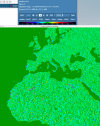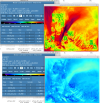Hi all,
I'm interested in testing the sub-grid gravity wave (gwd_opt=1 for real/wrf) over Europe and northern Africa. Doing so requires the use of the CON, OA1-4 and OL1-4 orography variables generated by geogrid. Unfortunately I'm finding that there are some artifacts in the CON and OA1-4 fields along 0 degrees Longitude (see the right panel of the plot below for an example of this), presumably because the dataset that is being used runs from 0 to 360 degrees longitude.
My domain grid resolution is 15km, which is close to the resolution of the 10 minute orography dataset that is used by default for these variables. I've tried applying smoothing masks and different interpolation options, these don't seem to do a lot to help. The best I've found is using the 20 minute orography dataset, which does eliminate the artifacts, but that seems to give a generally higher value for CON than using the 10 minute dataset (see left panel of the plot below).
So - my questions are:
1) how important are these artifacts (can I ignore them)?
2) are there any other methods that can be suggested to address this problem?
Thanks,
Doug

I'm interested in testing the sub-grid gravity wave (gwd_opt=1 for real/wrf) over Europe and northern Africa. Doing so requires the use of the CON, OA1-4 and OL1-4 orography variables generated by geogrid. Unfortunately I'm finding that there are some artifacts in the CON and OA1-4 fields along 0 degrees Longitude (see the right panel of the plot below for an example of this), presumably because the dataset that is being used runs from 0 to 360 degrees longitude.
My domain grid resolution is 15km, which is close to the resolution of the 10 minute orography dataset that is used by default for these variables. I've tried applying smoothing masks and different interpolation options, these don't seem to do a lot to help. The best I've found is using the 20 minute orography dataset, which does eliminate the artifacts, but that seems to give a generally higher value for CON than using the 10 minute dataset (see left panel of the plot below).
So - my questions are:
1) how important are these artifacts (can I ignore them)?
2) are there any other methods that can be suggested to address this problem?
Thanks,
Doug
&share
wrf_core = 'ARW',
max_dom = 1,
start_date = '2015-06-29_00:00:00',
end_date = '2015-06-29_18:00:00',
interval_seconds = 21600
io_form_geogrid = 2,
/
&geogrid
parent_id = 1
parent_grid_ratio = 1
i_parent_start = 1
j_parent_start = 1
e_we = 501
e_sn = 501
geog_data_res = 'default'
dx = 15000,
dy = 15000,
map_proj = 'lambert',
ref_lat = 32.0,
ref_lon = 10.0,
truelat1 = 32.0,
truelat2 = 32.0,
stand_lon = 10.0,
geog_data_path = '../geog/'
/






